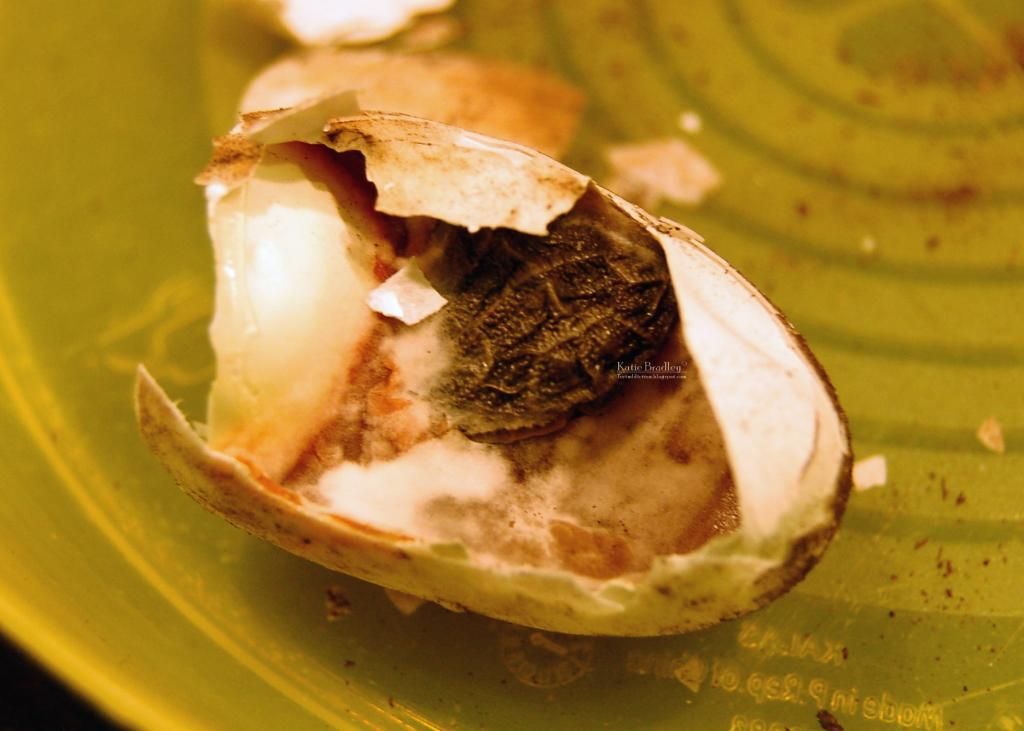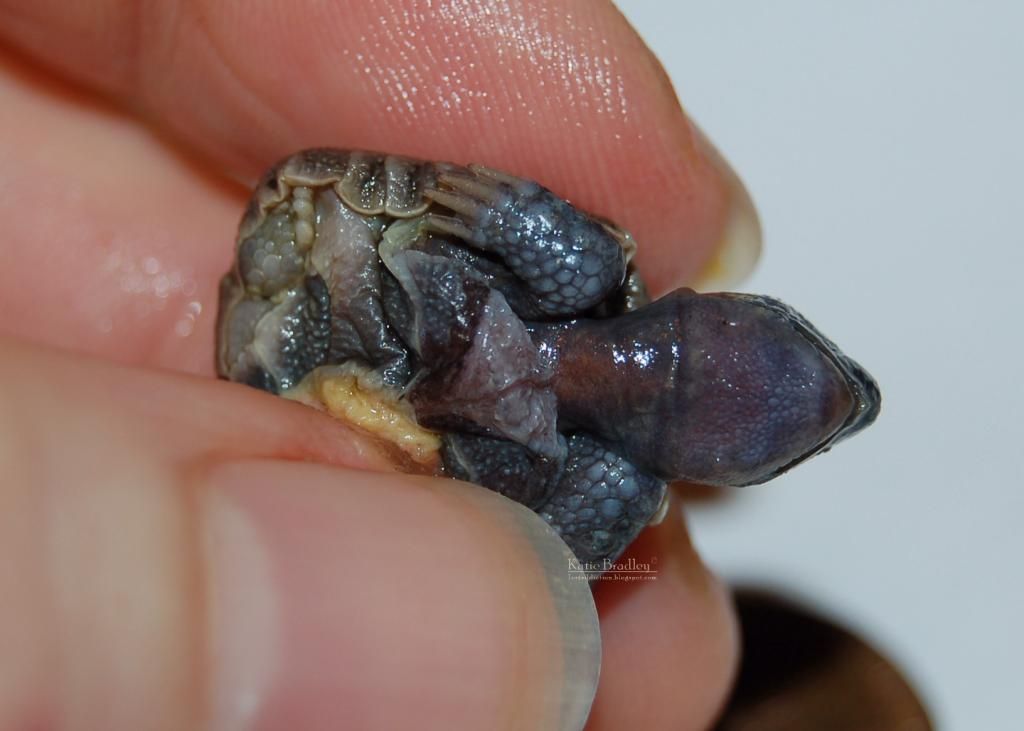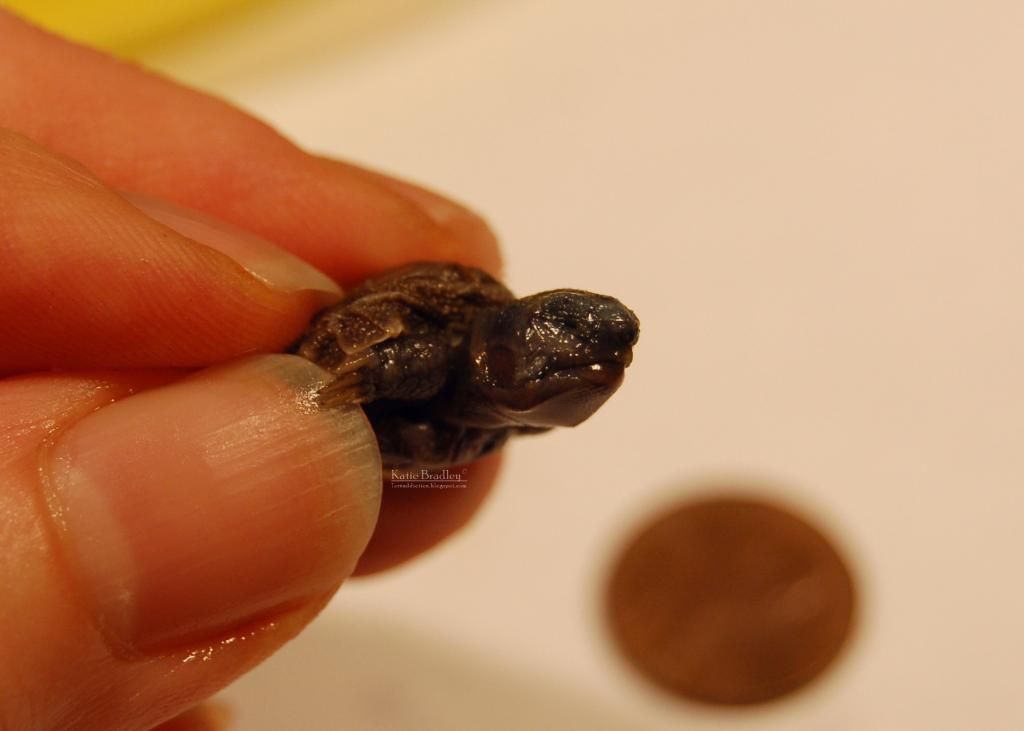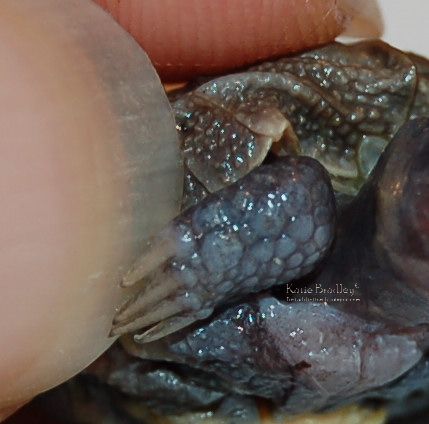First a warning: this post contains some pictures of a tiny dead Russian tortoise fetus. From a scientific perspective, they are very fascinating, but if you are very sensitive, I suggest you move on. There is no gore, but there are close-up pics of the fully formed miniature tortoise.
Now to the good stuff. On August 31, my female Russian tortoise 'Lady' laid 3 eggs into a nest outside. To the naked eye, they all looked great, though one of them had odd little lumps on one end. They weighed between 28g and 30g - a nice size! I placed them in the incubator at 89 degrees F, and waited. At about 5 weeks, I was getting out Mila's baby that had hatched, and quickly candled Lady's eggs without touching them. All 3 had veins. 2 looked normal, but I noticed that the egg with the lumps on the end was different: the membrane didn't fill all of the egg horizontally. About 1/3 of the egg was completely empty.
Today I needed to refill the water container in the incubator, and Lady's eggs are due to hatch any day. I candled again, and 2 of the eggs are completely dark, with a bubble on top, as expected of a fertile egg at this stage. The 'weird' egg, however, still had that 1/3 of void space, and it looked dried up and empty inside the part that had the membrane, except for an orange-ish smear at the bottom. I normally never handle the eggs while they are incubating, but I decided to weigh the egg. It weighed only 10g! This confirmed that the egg had died and dried up.
DISCLAIMER: I do NOT recommend opening an egg at any point in the incubation, even if it has gone past the 'due date,' unless you are VERY SURE that it is dead. Tortoise eggs from one clutch can develop at different rates, and can hatch several months apart. Be sure that a) candling shows the egg is dried up and b) weighing the egg confirms that it weighs less than half its lay-weight.
Being a scientist at heart, I decided to turn this small tragedy into a learning experience with my wonderful 8-year-old son. We took the egg to a well-lit area, and carefully opened it up. 1/3 of the egg was indeed completely empty, with the membrane not filling this part. Inside the membrane, I found dried up moldy stuff, and on one side, a tiny dead fetus was embedded in dried-up yolk. Its little shell was the size of my thumb nail. Surprisingly, there was no smell.
The picture below shows the moldy inside of the egg and the carapace of the fetus.

Using a toothpick and a small knife, I carefully pried the fetus from the dried-up stuff. Once I worked the fetus free, carefully leveraging it out of the congealed yolk, I saw a tiny blue tortoise face! The below picture also shows where the membrane was indented on the front left, rather than filling the egg. There were several tiny perforations in the membrane that the tiny fetus must have caused, resulting in the egg drying out subsequently.

I carefully (VERY carefully) lifted the fetus from the egg, and snipped off the yolk membranes from its belly, since they were dried up and I couldn't have removed the tortoise from the egg otherwise. I placed the fetus into some water to rinse off the icky stuff. The dried yolk and bits of mold came off easily. The tiny tortoise seemed to be encased in a thin skin, which I opened, and carefully stripped it off the head, legs, and carapace. Here's a picture of the freshly cleaned fetus:

Can you believe the perfection of its tiny features? You can see where its internal ears are developing, i, it has a tiny beak, its tightly closed eyes, tiny claws on each foot, and even a stubby little tail.
Turning the fetus over, the plastron had the same consistency as the skin, and was still folded up on itself. This was interesting to me, because in my mind, the tortoise fetuses didn't curl up into sit-up position until they started running out of space inside the egg. However, this tortoise fetus was very much folded in half, just like the more developed hatchling counterpart.

I find it amazing that every scale, claw, and scute is already visible at this early stage of development.
Here is another view of the fetus' tiny face in different lighting.

Here is a picture of the tiny Russian tortoise fetus next to a penny, for size comparison:

I am especially fascinated with how fully formed this tiny creature is. The proportions are alien, but all the 'pieces' are present, and just need to grow, harden, and mature. I wish I had a way to preserve this fascinating specimen - I placed it in vinegar for now, and will call our local High school on Monday to see if their biology teacher would like to preserve it in formaline. If not, I will bury it under some day-lilies in our garden.

I am curious: does anyone here know in what week of development this little one died? @N2TORTS ? @Tom ? @Yvonne G ? @TylerStewart ?
Now to the good stuff. On August 31, my female Russian tortoise 'Lady' laid 3 eggs into a nest outside. To the naked eye, they all looked great, though one of them had odd little lumps on one end. They weighed between 28g and 30g - a nice size! I placed them in the incubator at 89 degrees F, and waited. At about 5 weeks, I was getting out Mila's baby that had hatched, and quickly candled Lady's eggs without touching them. All 3 had veins. 2 looked normal, but I noticed that the egg with the lumps on the end was different: the membrane didn't fill all of the egg horizontally. About 1/3 of the egg was completely empty.
Today I needed to refill the water container in the incubator, and Lady's eggs are due to hatch any day. I candled again, and 2 of the eggs are completely dark, with a bubble on top, as expected of a fertile egg at this stage. The 'weird' egg, however, still had that 1/3 of void space, and it looked dried up and empty inside the part that had the membrane, except for an orange-ish smear at the bottom. I normally never handle the eggs while they are incubating, but I decided to weigh the egg. It weighed only 10g! This confirmed that the egg had died and dried up.
DISCLAIMER: I do NOT recommend opening an egg at any point in the incubation, even if it has gone past the 'due date,' unless you are VERY SURE that it is dead. Tortoise eggs from one clutch can develop at different rates, and can hatch several months apart. Be sure that a) candling shows the egg is dried up and b) weighing the egg confirms that it weighs less than half its lay-weight.
Being a scientist at heart, I decided to turn this small tragedy into a learning experience with my wonderful 8-year-old son. We took the egg to a well-lit area, and carefully opened it up. 1/3 of the egg was indeed completely empty, with the membrane not filling this part. Inside the membrane, I found dried up moldy stuff, and on one side, a tiny dead fetus was embedded in dried-up yolk. Its little shell was the size of my thumb nail. Surprisingly, there was no smell.
The picture below shows the moldy inside of the egg and the carapace of the fetus.

Using a toothpick and a small knife, I carefully pried the fetus from the dried-up stuff. Once I worked the fetus free, carefully leveraging it out of the congealed yolk, I saw a tiny blue tortoise face! The below picture also shows where the membrane was indented on the front left, rather than filling the egg. There were several tiny perforations in the membrane that the tiny fetus must have caused, resulting in the egg drying out subsequently.

I carefully (VERY carefully) lifted the fetus from the egg, and snipped off the yolk membranes from its belly, since they were dried up and I couldn't have removed the tortoise from the egg otherwise. I placed the fetus into some water to rinse off the icky stuff. The dried yolk and bits of mold came off easily. The tiny tortoise seemed to be encased in a thin skin, which I opened, and carefully stripped it off the head, legs, and carapace. Here's a picture of the freshly cleaned fetus:

Can you believe the perfection of its tiny features? You can see where its internal ears are developing, i, it has a tiny beak, its tightly closed eyes, tiny claws on each foot, and even a stubby little tail.
Turning the fetus over, the plastron had the same consistency as the skin, and was still folded up on itself. This was interesting to me, because in my mind, the tortoise fetuses didn't curl up into sit-up position until they started running out of space inside the egg. However, this tortoise fetus was very much folded in half, just like the more developed hatchling counterpart.

I find it amazing that every scale, claw, and scute is already visible at this early stage of development.
Here is another view of the fetus' tiny face in different lighting.

Here is a picture of the tiny Russian tortoise fetus next to a penny, for size comparison:

I am especially fascinated with how fully formed this tiny creature is. The proportions are alien, but all the 'pieces' are present, and just need to grow, harden, and mature. I wish I had a way to preserve this fascinating specimen - I placed it in vinegar for now, and will call our local High school on Monday to see if their biology teacher would like to preserve it in formaline. If not, I will bury it under some day-lilies in our garden.

I am curious: does anyone here know in what week of development this little one died? @N2TORTS ? @Tom ? @Yvonne G ? @TylerStewart ?